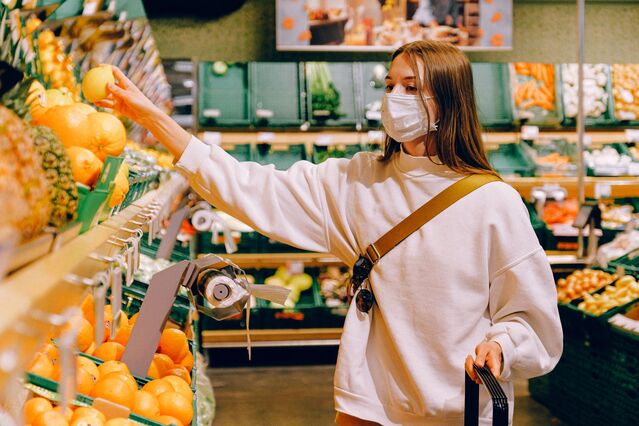Psychology
Facial Paralysis Gave Me a "Mask-Like" Face
A psychologist with facial paralysis on how to communicate while wearing a mask.
Posted July 27, 2020 Reviewed by Devon Frye

I was born with a rare disorder called Moebius syndrome, which means I have facial paralysis and a lack of lateral eye movement. Articles in medical journals coldly describe the faces of people with Moebius syndrome as "mask-like." I always found this description confusing and even dehumanizing. My face is not a mask; it’s just a face that doesn’t move much.
I spent the first half of my life pretending that there was nothing different about my face, not discussing it with even my best friends, and avoiding questions about it. Back then, I would have loved the excuse to hide my difference with a mask. In school, I was bullied especially viciously around Halloween. Kids told me I didn’t need a mask because I was already scary, or conflictingly, that I should cover up with one.
Now, as a psychology professor who researches facial paralysis and disability, I’ve devoted my career to educating about and advocating for people like me. And with the sudden rise of mask-wearing, for the first time in my life, I have the opportunity to be in public and blend in. But at this point, I’ve grown to like my distinctiveness. Our faces are the symbol of our identity, and my confidence in it is hard-won. I wear a mask in public because it is the right thing to do for public health during the COVID-19 pandemic. That said, wearing a mask brings up complicated feelings.
More than 250,000 people in the United States are diagnosed with facial paralysis each year. It can be congenital, like Moebius syndrome, hemifacial microsomia, or damage to the facial nerve during birth. More commonly, it is acquired at some point later in life from an illness or an injury. Bell’s palsy, acoustic neuroma, Ramsay Hunt syndrome, Lyme disease, stroke, multiple sclerosis, ear infections, and other conditions can all lead to chronic facial paralysis.
Being in public is probably the most trying situation for people with facial paralysis, and thus where it is most tempting to cover one’s face. My face is not novel to my family and friends. They’ve learned to recognize all my expressive cues. But most strangers have never seen a face that looks like mine or even heard of facial paralysis. They stare, often out of curiosity, sometimes out of malice. They may mistake people with facial paralysis as unfriendly, unhappy, or even intellectually disabled.
People with facial paralysis have to work hard to stamp out these first impressions. For these reasons, people with facial paralysis and other facial differences are already at greater risk of isolation, which may be amplified during COVID-19. Many have a history of hiding away to avoid staring and discrimination. While important, stay-at-home orders and masks may inadvertently undermine resilience by reinforcing old habits of social avoidance.
Some of my earliest research examined the expressiveness of people who were born with facial paralysis and those who acquired it later. Regardless of the severity of the paralysis, I found that people with congenital facial paralysis had adapted better than those who acquired it. My work suggests that being born with a disability confers an adaptation advantage over acquiring it later, perhaps because it occurs during initial identity development and a period of great cognitive flexibility.
People with congenital facial paralysis use more of what I call “alternative expression.” That is, they expertly rally the other communication channels available to them: body language, laughter, tone of voice. An unusually large number of people with facial paralysis are writers. Some of us engage in careful styling to assure people that we are indeed professional, competent, fun, etc. One woman with Moebius syndrome I interviewed started wearing a happy face pin and found that people were friendlier to her.
People without facial paralysis are suddenly experiencing what it’s like to have limited facial expression. The first time my husband wore his mask in public, he smiled at a cashier and the cashier (who for some reason was not wearing a mask) did not smile back. How would the cashier know my husband was being polite and friendly? Those of us who have been living with facial paralysis for a long time are at an advantage when communicating while wearing a mask. The first thing I did when I started wearing a mask was engage my alternative expression skills to find a fun, cheerful mask. Pandemic, but make it fashion! I know how to smile with my voice and pepper in laughs.
Wearing a mask to prevent the spread of COVD-19 is a real-life, imperfect simulation of facial paralysis. Disability simulations are well-meaning but often counterproductive attempts to increase nondisabled peoples’ understanding of disability by aping the disability experience in some way (e.g. wearing a blindfold and trying to navigate a room to simulate blindness). These activities simulate the immediate acquisition of a disability, a scary time when one has not yet learned adaptations. A 20-minute simulation will not demonstrate the skills or mastery that a disabled person develops over time. Experiments show that when nondisabled people engage in disability simulations, they feel more sympathy for disabled people yet simultaneously see them as incompetent. Simulations are more effective when paired with education about adaptations disabled people engage in, showcasing their competence.
My research shows that when people are educated about facial paralysis and attend to alternative expression, they are less likely to stigmatize people with facial paralysis. I’m glad that people are thinking about what it is like to have limited facial expression now, and we must be cautious of the dangers of disability simulation. Wearing masks may lead people to feel more sympathy AND pity for people with facial paralysis, unless they consider the creative ways people with limited facial expression adapt. Let’s try funky mask fashion, exuberant gestures, and voice-smiles. I hope this grand simulation will make everyone more attuned to expressive diversity.




